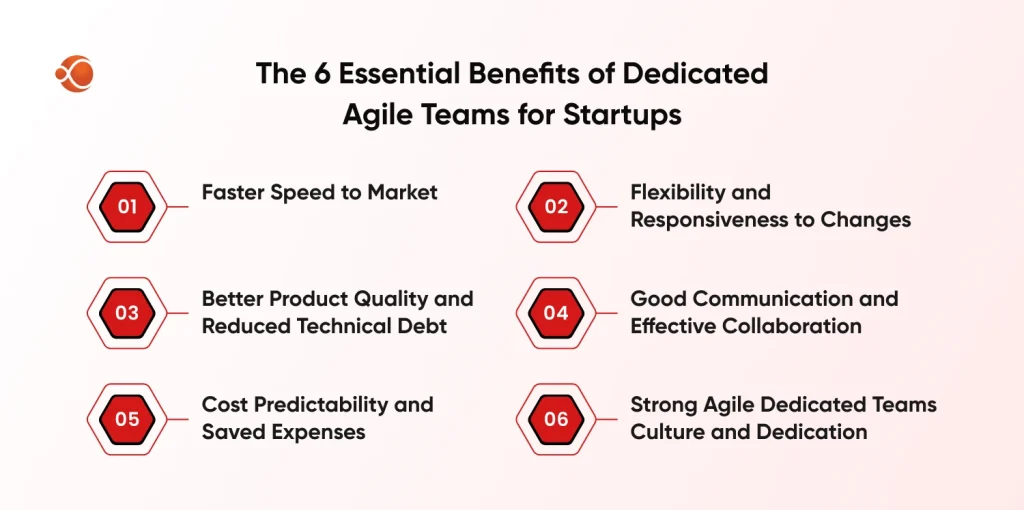Quick Summary: When should a startup switch to dedicated teams for agile development? If hiring delays, scaling challenges, or technical debt hold you back, this blog shows how dedicated agile teams solve these pain points and accelerate product growth.
As a startup founder, do you fear losing your market while waiting to build the right development team? Balancing speed with quality is a continuous challenge faced by startups. Move too fast, and technical debts from hasty code structure and broken architecture stall your growth. Move too slow, and competitors get the first-mover advantage over you. Traditional solutions often fail to capture and keep up with the dynamics of this ever-evolving market, staff augmentation lacks ownership, and internal hiring takes too long, and is often expensive.
So what can differentiate your startup from the competition and provide it with the exact resources you need at the most optimal cost, and at the right time? Dedicated teams for agile development or Dedicated Agile Teams(DAT). They provide focus, expertise, and accountability that help startups to scale rapidly without having to sacrifice quality. From day one, your product is built with dedication, turning development into a strategic asset.
What is a Dedicated Agile Team (DAT)?
A dedicated agile team is more than simply outsourced staff. They are a long-term, self-contained, and integrated development unit that focuses solely and dedicatedly on your product and business goals. These dedicated teams for agile development can be contracted from any software development company that provides such hiring options. Even if they work with the outsourcing agency, they act as an exclusive, committed extension of your company, functioning like a full-time off-site development department.
Reasons for Choosing Dedicated Teams for Agile Development
According to a recent report, these are the primary reasons startups and enterprises choose dedicated teams for Agile development:
| Reason for Choosing Agile Development | Percentage of Voters |
| Accelerate software delivery | 71% |
| Enhance ability to manage changing priorities | 63% |
| Increase productivity | 51% |
| Improve business/IT alignment | 47% |
| Enhance software quality | 42% |
| Enhance delivery predictability | 39% |
| Reduce project risk | 37% |
| Improve project visibility | 36% |
| Improve team morale | 31% |
| Reduce project cost | 26% |
| Improve engineering discipline | 23% |
| Better manage distributed teams | 21% |
| Increase software maintainability | 18% |
What are the Core Characteristics of Dedicated Agile Teams?
Complete Focus on Your Product
Team members work 100% on your product and are not rotated or shared with other projects. This unwavering focus and commitment minimize the chances of context-switching that affects fluid contract work and hourly gigs negatively. This continuity ensures they retain deep knowledge about your architecture, code, and product logic. What does this translate into for your startup? Faster iterations, fewer errors, less onboarding for new features.
Cross-Functional and Self-Managing
DATs are a complete package in terms of all the skills needed to complete your project. Dedicated Agile Teams consist of developers, designers, QA engineers, deployment experts, project managers and many other roles, each capable of handling their tasks independently. They organize their own work, run stand-ups, and manage sprints, needing minimal oversight. The startup founder finds more time to focus on strategy rather than micromanaging daily development.
Flexible Location: Co-Located or Distributed
Dedicated agile teams can work from a single location for multiple time zones. What matters most is commitment and collaboration, not their physical location. Such flexibility allows startups to find global talent with specialized skills at much lower costs, fitting their budget constraints.
Dedicated Agile Team Roles and Responsibilities Towards Startups
Here is a detailed explanation of the functioning and composition of a high-performing dedicated agile development team.
| Role | Primary Focus | Key Responsibilities | Startup Benefit |
| Product Owner | Vision & Priorities | Defines features, prioritizes backlog, ensures business value | Translates founder’s vision into actionable tasks, keeps roadmap aligned |
| Business Analyst | Requirements & Market Fit | Researches market, documents requirements, analyzes competitors | Ensures product meets user needs and regulations |
| Scrum Master | Process & Team Support | Facilitates Agile ceremonies, removes blockers, enforces Agile principles | Protects team from scope creep, ensures smooth delivery |
| Product Delivery Manager | Strategic Oversight | Manages budget, resources, and communication with leadership | Maintains alignment with long-term delivery goals |
| Software Developers | Product Build | Full-stack, front-end, back-end development, clean code, architecture | Builds functional features quickly with adaptability |
| UI/UX Designers | User Experience | Design interfaces, ensure usability and visual appeal | Faster design decisions, higher-quality product |
| QA Engineers | Quality Assurance | Test features, catch bugs, maintain product reliability | Reduces technical debt, ensures production-ready software |
The Visionaries: Product Owner and Business Analysts
- Product Owner: The Product Owner or PO represents the customer and the business. They decide what they want to build next, prioritize the backlog, and ensure each feature adds maximum value to the client. In a startup, the role of a product owner is to translate the founder’s vision into actionable user stories that the agile developer team can use to stay on the right trajectory when working on the project.
- Business Analysts: The BA supports the product owner by researching the market, documenting all requirements, and analyzing competitors. They make necessary updates to ensure that technical requirements align with user needs and regulations.
The Facilitators: Scrum Master (SM) and Product Delivery Manager (PDM)
Scrum Master: The SM guides the agile dedicated teams on how to implement the Agile principles. They are also responsible for running meetings like sprint planning, daily stand-ups, reviews, and retrospectives. Having an SM as part of your agile development team protects your project from scope creep and ensures consistent delivery.
Product Delivery Manager: They often work with the scrum master and are responsible for managing resources, budgets, and communication with leadership.

The Builders: Developers, UI/UX Designers, and QA Engineers
Software Developers: These are the talents that code your project to life, and usually consist of profiles like full-stack developers, backend developers, frontend developers, and other such profiles. The PO defines the required features, which the developers build on. They follow coding best practices for maintaining clean code, robust architecture, and adapt fluidly to changing requirements between sprints.
UI/UX Designers: They make your product functional and add visual appeal to the project. Their contribution makes a significant contribution to attracting more users to your product and retaining them as well.
QA Engineers: Hiring QA engineers as part of building dedicated teams for agile development is very important. They are the defenders against technical debt and perform thorough testing to catch bugs early, ensuring the product meets high-quality standards before launch.
Three Dedicated Agile Team Models: How to Structure Your Team
The flexibility of dedicated agile teams enables teams to work on their composition in various ways. They can do it to suit their product type, business objectives, and growth stage. Choosing the right software development methodologies is a strategic decision and a key factor for selecting the right software development partner.
1. The Generalist Team (The MVP Engine)
For startups looking to launch quickly and test the market, going for a generalist team is the best approach. This agile team development model handles both frontend and backend tasks, allowing your team to build an MVP or proof of concept fast. This model focuses on speed and delivering core features so you can gather real user feedback without committing to expensive developers too early. It is ideal for validating your idea and moving fast.
2. The Domain Specialists (The Scalability Model)
If your startup is based on complex or niche technology, you should opt for the domain specialists team structure. These teams are built of experts who understand the intricacies of your industry and technology requirements. They can work on various projects, be it agile development for AI-First SaaS, building a fintech platform, or integrating popular products like QuickBooks, Xactanalysis, and others.
3. The Hybrid Team (The Co-Pilot Model)
If you want to scale development while maintaining strategic control, you need to hire a dedicated development team model using the Hybrid team model. External dedicated developers handle all coding, testing, and feature delivery tasks. Your internal team focuses on the vision, architecture, and critical decision-making. This agile team model provides both speed and control over intellectual property and product direction.
The 6 Essential Benefits of Dedicated Agile Teams for Startups

The DAT model provides many structural advantages that directly address the most common growing pains and obstacles faced by early-stage companies. This transforms their operational efficiency and product output. Here are some of the top dedicated team advantages for your agile startup:
1. Faster Speed to Market
A dedicated team is a high-velocity delivery engine. The minimal context-switching speeds up the development cycles, enabling teams to stay focused on their project without having to work on multiple projects simultaneously. With a single-focused and empowered team, features are faster from concepts to deployment, allowing quicker feature releases, immediate integration of user feedback, and other critical market pointers.
This rapid iteration is the fundamental competitive advantage any startup needs for testing hypotheses, achieving product-market fit, and getting ahead of competitors. This is a key aspect of agile development for startups.
2. Flexibility and Responsiveness to Changes
In the startup world, change is inevitable, and it is fast. Products can pivot, funding dictates scope changes, and user feedback can point out the need to make drastic changes in direction. Long-lived DATs that understand the codebase are going to be better at handling the frequent, disruptive changes, common in the startup lifecycle. Such teams can implement sweep changes requested by the Product Owner, with greater precision, speed, and confidence.
3. Better Product Quality and Reduced Technical Debt
Technical debt is the hidden cost of poor and rushed code, it is also known as the silent killer of startups. The DAT model directly counters such issues by creating a culture for shared responsibility and long-term investment.
The dedication to common long-term goals results in higher coding standards, more thorough peer reviews, and much better quality control. Any team that is invested in the product’s future will itself avoid cutting corners. They will make the foundation scalable, keeping your project modular and integration-friendly with any future services or solutions.
4. Good Communication and Effective Collaboration
Effective collaboration requires trust, transparency, and a shared understanding between developers. The constant, full-time interaction with a dedicated agile team fosters deep, trusting relations between team members and your internal stakeholders.
By using standardized web development team structure and agile development best practices, the team works with reduced communication lag, and keeps track of all communications. Also, the dedication towards transparency helps connect the gap between distributed agile teams.
5. Cost Predictability and Saved Expenses
Startups operate under intense financial scrutiny. Hence, it is important that they have an accurate estimate of their upcoming costs and budget constraints. The dedicated agile team model eliminates the overhead associated with internal hiring, like salary fees, HR administration, payroll taxes, benefit packages, and office spaces.
6. Strong Agile Dedicated Teams Culture and Dedication
Developers hired through staff augmentation are often considered temporary contractors. Some startups find it difficult to trust them with their long-term vision and goals. However, with dedicated teams for agile development, their integration into the startup’s mission and culture happens seamlessly. Startups find a sense of ownership and commitment to the product’s success by celebrating product milestones and sharing the urgency of launch deadlines.
When to Hire a Dedicated Agile Team? Checklist for Startups
As a startup founder, one of the toughest decisions is knowing when to move from a small foundational crew of developers to a fully dedicated agile team. A dedicated agile software development team is not just a bigger team; it is a strategic extension of your startup.
The Critical Timing Checklist
1. Rapid Scaling and MVP Launch
Are you racing to launch an MVP or get started in a new market, but don’t have enough resources or time to hire and train full-time in-house teams? A dedicated agile team provides instant scalability, letting you ramp up quickly without sacrificing quality. This is especially ideal for building an AI-first SaaS product or tackling complex tech stacks.
2. Specialized Technical Depth
Does your project require specialized, deep technical expertise like data science, complying with a particular financial compliance, or specialized software development solution like building an AI-powered personalized recommendation system? The cost of hiring one specialized developer internally can often cover several experts in a dedicated team model setup.
3. Long-Term Product Roadmap
Is your product roadmap long-term, maybe 6 months or more, and requires continuous development and long-term support? Team continuity and preservation of industrial knowledge is very important for such projects.
4. Flexible Capacity Needs
Next, when looking for a scrum development team, ask yourself if you need flexible capacity for your business that can reliably grow and shrink the team size based on external cycles like funding cycles, feature expansion, or planned maintenance. The DAT models will allow such scaling and descaling, providing unlimited flexibility in the DevOps agile development cycle.
Warning Signs That Indicate Urgent Need For A Dedicated Agile Team
Startups often wait too long, only looking for a DAT when they encounter chronic issues. These are organizational “red flags” that you should take as signals that a dedicated agile team is required:
High Developer Turnover
Relying on freelancers or temporary staff leads to constant knowledge loss and repeated bugs.
Constant Missed Deadlines
This is often a symptom of poor requirements gathering or internal communication friction.
Bloating Technical Debt
Are your costs of fixing old bugs exceeding your costs of building new features? Make sure to hire dedicated teams for agile development immediately.
Founder Overload
The CEO spends more time managing JIRA tickets and debugging than talking to the investors or customers.
How to Build Your Dedicated Agile Team for Success
Building a successful partnership goes way beyond signing a contract. It requires establishing clear expectations, communication channels, and shared cultural alignment.
1. Define Success Metrics Clearly
Before onboarding, define the measurable success metrics that go beyond simple lines of code. Metrics should always be measured in terms of business value. Here are the four business metrics you should consider:
- Velocity: The consistent rate at which the team delivers features.
- Quality: Achieving a low bug-to-feature ratio and higher test coverage.
- Time-to-Market: The speed of concept-to-deployment.
- Engagement: The team’s voluntary participation in product discussions and problem-solving.
2. Establish the Product Owner Role
While the team is externally managed, the product owner role should be internal or fully integrated with the core team. The PO is the funnel through which all decisions and priorities are filtered. Their availability and clarity are the two biggest factors behind the success of any dedicated agile team. They need to dedicate sufficient time (10-20 hours per week) for clarification, review, and sprint planning.
3. Ensure Technical Alignment
If you are working on a complex project, it is very likely that your development effort can result in a scope creep. To avoid such a situation, make sure the dedicated agile team architecture leadership aligns with any long-term internal technical vision. Doing so will avoid future conflicts, by coming on terms regarding technologies, cloud architecture, and coding standards upfront.
Why Choose CMARIX for Hiring Dedicated Teams for Agile Development
CMARIX is positioned as a strong partner for startups seeking a dedicated agile team model, especially through an offshore development center. Hire dedicated developers from CMARIX to get access to some of the best talents in AI, web, and mobile development across all industries. Our cost-effective and diverse talent pool provides all the benefits of agile development teams and collaboration needed for agile success.
Final Words
In the competitive race of building the next big thing, focus is the biggest virtue for a startup. Time spent in recruiting, onboarding and managing internal developer logistics, is time stolen from pursuing growth and vision. When you choose a dedicated agile team, you don’t just hire temporary employees, you build a full functional, self-optimizing development engine.
You get immediate access to specialized developers for building complex software solutions, or even AI infrastructure, with predictable costs and a team of dedicated maestros. The strategic choice allows your core leadership to laser-focus on the business vision, customer acquisition, and growth strategy.
FAQs on Dedicated Teams for Agile Development
What Is an Agile Development Team?
An Agile development team is a small, cross-functional team of developers, testers, and designers that collaborates to create software incrementally. They are focused on flexibility, fast delivery, and ongoing improvement, so they are best suited for startups that have to move fast and change in response to shifting markets.
Why Is Agile Methodology Well-Suited for Startups?
Agile allows startups to experiment with ideas fast, gather insights, and make changes without losing time and resources. Through short cycles and regular releases, teams can minimize risk, maximize efforts, and grow effectively as the market and product develop.
How to Ensure Good Communication With a Remote Dedicated Agile Team?
Clear expectations, daily stand-ups, and open documentation keep everyone aligned. Video conferencing, messaging apps, and collaborative tools enable real-time communication. This allows remote teams to stay in sync and accountable across different time zones.
What Are the Three Main Roles in an Agile Team?
Product Owner: Prioritizes business objectives.
Scrum Master: Eliminates impediments and enables processes.
Development Team: Develops, constructs, and tests the product.
Every role maintains a productive, responsible, and speedy team.
What Is the Difference Between an Agile and Scrum Team?
Agile is a mindset and a set of principles for iterative and flexible development. Scrum is a framework used to implement the best agile principles, with established roles, ceremonies, and artifacts. All Scrum teams are Agile, but not all Agile teams practice Scrum rigidly.







